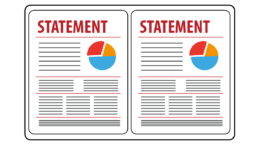N-Up
Rubika® is able to adjust the layout of the output data so it is formatted in “N-up” fashion, where two logical sheets are arranged to print on one larger physical sheet. For instance, you might render US Letter and A4 documents in a N-up scheme on US Ledger or A3 media, respectively.
- Output is typically formatted as N-Up to accommodate printer and finishing equipment requirements.
- Formatting output as N-Up on larger paper can also be used as a way to reduce printer click charges and paper usage.

The N-Up Module methods: Sequential vs. Stacked.
Sequential
The N-Up step arranges the input sheets on the output media so that the left side of the front is an odd sheetlet number and the right side of the front is the next even sheetlet number. The back side of the output sheet is set up to match appropriately: if the input data is duplex, the original duplexing is reproduced; if the input data is simplex, the back side of the output sheet will be blank.
Stacked
The N-Up step arranges the input sheets on the output media so that the stack of input sheets is divided by N. Sheets 1 through N/N render on the left side of the output stack and sheets (N/N)+1 through N render on the right side of the output stack, where N is the total number of sheets to be presented in N-up fashion. The back side of the output sheet is set up to match the original plex of the input data.
With the built-in software automation, the Solimar solution has increased our overall output production by 15%Alvaro Diaz, General Manager AMF Impresion Variable S. A
We were able to reduce our customer project turnaround time by 75%...other automated improvements helped increase our production output by approximately 200%Anthony Fenner, Manager Application Development Apex Information Technologies
